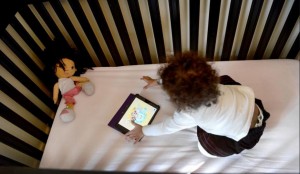There have been many studies that have demonstrated links between excessive childhood screen time and negative outcomes including attention problems and aggression. Most of them imply causation but generally can’t prove it because the studies don’t measure child behavior before the screen time occurs. Yes playing Minecraft for 6 hours per day might cause problems, but it could also be true that kids whose have attention problems are drawn more to the bells and whistles of video games. A recent study published in the journal Pediatrics examined this question in relation to poor infant self-regulation and media usage at age 2.
The study comes from the Early Childhood Longitudinal Study – Birth Cohort and included 7450 children from the community, oversampled for higher rates of ethnic minorities. Infants were assessed for the regulatory abilities at an age of 9 months using a shortened version of the Infant Toddlers Symptom Checklist. Items involving fussiness, needing constant attention, and sleep problems loaded onto the overall score of regulation problems. Media usage was measured at age 2 by simply asking caregivers about average media use. Regression analyses were performed to examine the link between infant regulatory abilities and media use, controlling for other potential confounds. The authors examined the data both quantitatively (i.e. using the actual numbers of media time) and categorically dividing toddlers into groups that watched more or less than 2 hours per day (based on the AAP guidelines of two hours per day maximum of screen time).
Overall, a small but statistically significant link was found between infant regulatory abilities and age-two media use. The analyses showed that children with poorer regulatory skills (which was about 39% of the sample) consumed approximately 14 more minutes (9 minutes when adjusted for other variables) of media per day than those with good regulatory skills. At age 2, children averaged about 2.3 hours of media use per day with 40% of the sample going above the recommended 2 hours per day. The association between dysregulation and media use was stronger for children who remained dysregulated at age 2 and for children from English speaking and lower SES families.
The authors’ conclusions were somewhat unexpected. Despite showing evidence that dsyregulation might be a cause rather than a result of media use, the authors argued that the amount of use associated with infant dysregulation was too small to account for the finding from other studies that excessive screen time is linked to negative child behavior. They cautioned about a cycle in which fussier infants are more likely to be placed in front of screens (to give parents a break or occupy them in a safe place) which then in turn exposes them to the negative effects of increased screen time and thus reinforces the initial problem. While this is certainly a plausible hypothesis, it requires a study that assesses child behavior, parent behavior, and screen time at multiple time points. We are still waiting for that one, as far as I know.
Reference
Radesky JS, et al. Infant Self-Regulation and Early Childhood Media Exposure. Pediatric; online publication April 14, 2014
Tags: fussy, ipad, screen time, self regulation, television

